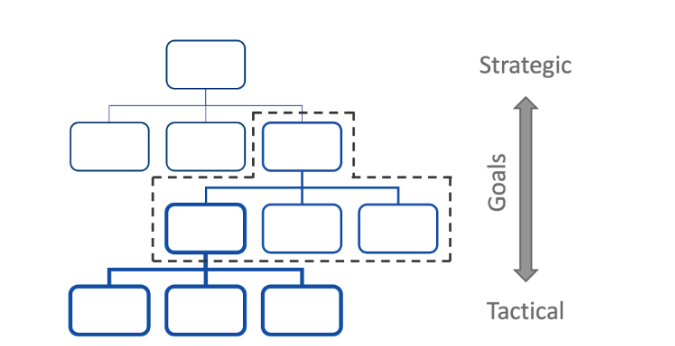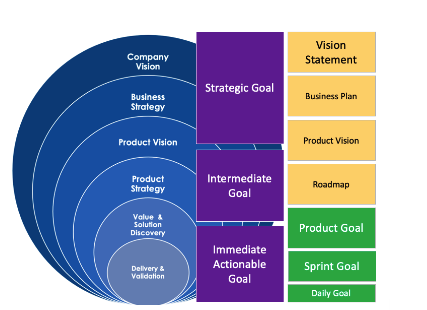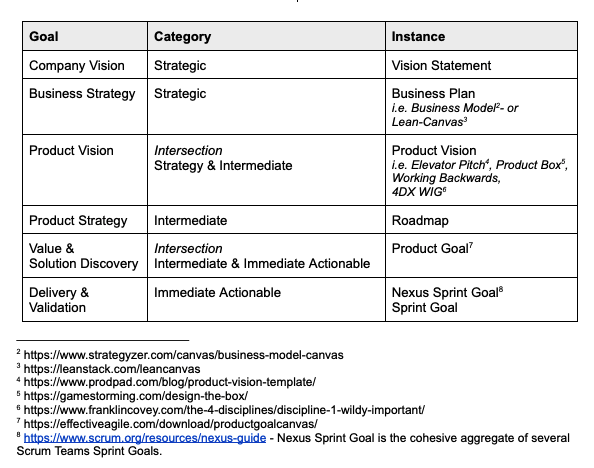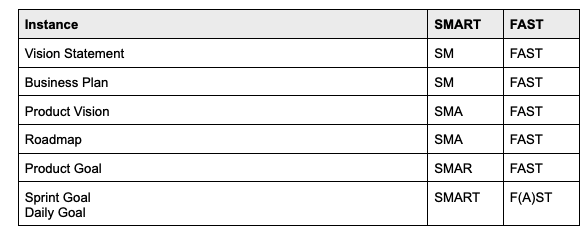Grand ideas, visions are everywhere. Governments, businesses and NGOs have aspirational goals. However, the larger the goal, the higher the chance that the original intention gets lost while being passed through the structural layers of the organization. Risks, politics, personal agendas often subvert the original goal either by design or unwittingly, turning high impact outcomes into mediocre outputs. The mere act of decomposing an organizational goal into department and team goals can also cause the essence of the strategic organizational goal to become lost. This blog aims to shed some light on the underlying forces at play and how good goal setting with well-chosen metrics can help. I hosted a webinar on this topic on April 14. You can watch here.
Goal Categories
Goals fall into three categories: Strategic, Intermediate and Immediate Actionable as shown in Figure 1. This classification is important as it has an influence on communication and measures.

Figure 1 Product Management Onion with Goals and their Categories
Goal Categories*:
- Strategic Goal is something important that the organization would like to achieve. This goal is so big and far away, with many uncertainties along the journey that the organization must use empiricism. Because the Strategic Goal is aspirational and the path to it is uncertain, the organization needs a series of practical targets, like
- Intermediate Goals, achievements of which will indicate that the organization is on the path to its Strategic Goal. The path to the Intermediate Goal is often still somewhat uncertain, but not completely unknown.
- Immediate Actionable Goals, critical known near-term tactical objectives toward which a team or group of teams will work help toward Intermediate Goals.
*Based on EBM Guide Sept 2020, https://www.scrum.org/resources/evidence-based-management-guide
A company vision might span several business strategies which concludes that higher- and lower-level goals might represent a 1-many relationship. High level, strategic goals themselves are usually not enacted directly themselves but through smaller tactical sub-goals. Higher-level goals are the aggregate of the outcomes of the sub-goals.

Figure 2 One-to-Many Relationship from Strategy to Tactics
One of the negative side effects of this break-down is that they coincide with inner-company boundaries like business-hierarchies and departments. The resulting disconnect caused by those boundaries causes a vacuum with a dilution of understanding.
Goal Instances
Each category spans a rather large area on the product management onion. For more granularity they are often broken down into different instances as shown in Figure 4 and Table 1.

Figure 4 Goal Types

Table 1 Goal Mapping
Two of the goals: Product Vision and Value & Solution Discovery, intersect with two of the categories. These goals can be considered as the logical glue at critical interfaces, ensuring consistency, therefore making them especially important.
Most of us have been taught that good goals are supposed to be SMART:
Specific, Measurable, Attainable, Realistic and Time-Bound
Is this always the case? For example, a vision statement is specific and measurable, is it also attainable, realistic and time-bound? Maybe, however, not likely when considering the complexity and the span in which is being operated. In contrast a Sprint Goal fulfills all the criteria of SMART as a Sprint is more complicated and less complex, happening in a short defined time frame.
There is also the FAST* acronym:
*Pioneered by Google, Intel and InBev https://sloanreview.mit.edu/article/with-goals-fast-beats-smart/
Frequently Discussed, Ambitious, Specific, Transparent
A vision statement needs to be frequently discussed, ambitious, specific and transparent. The Sprint Goal should be discussed each day at the Daily Scrum, it is ambitious but realistic as well as specific and transparent.

Table 2 Goal instances comparison
Looking at the comparison, FAST goals seem like the better choice when creating high level goals. Especially since SMART goals undervalue ambition and focus narrowly on individual performance thereby ignoring the importance of discussing goals continuously. Even better, FAST goals tend to be more outcome and less output oriented.
Benefits of using Goals
Goals provide context and a shared alignment between all the people engaged. The resulting directed focus helps to prioritize and make decisions. Having urgency is a great motivator and starting point as shown in John Kotter’s 8-Steps process.
Figure 5 The 8-Steps Process for Leading Change*
* https://www.kotterinc.com/8-steps-process-for-leading-change/
This process for change is mostly applicable for high level strategic goals like company vision and business strategy. However, the clarity of urgency is also beneficial for product related work. Being late to the market could have a significant impact on the attainable market-share.
Between each of the layers in the product management onion is a possible handover. Handovers are always non-optimal; one of the negative aspects is loss of understanding. To counteract this, it is paramount to create an all-encompassing shared understanding. This understanding allows for the right communication, the narrative through all layers. From vision to validation. A good way to think about this communication from the top to down is the commander's intent. Commander's intent* means explaining why something must be done when delegating work. The more the purpose is understood, the better the outcome will be. The further down the intent moves, the more it is being transformed from being strategic to tactical. By being clear about the purpose, providing the global and local narrative, all involved can act toward that goal autonomously. The creation and communication of the narrative behind the goal, requires the right types of conversations as described by Mary Boone and Dave Snowden in their seminal paper ‘A Leader’s Framework for Decision Making’*. In order to make the best possible decisions an increased level of communication and interaction is required. It is about having the right conversations with focus on a specific outcome. The combination of sense of urgency, focus on outcome over output through a continuously communicated narrative is very powerful and makes it obvious that the why is more important than the what.
* https://en.wikipedia.org/wiki/Intent_(military)
*Mary Boone and Dave Snowden, 2007, A Leader’s Framework for Decision Making, Harvard Business Review Press
Once the why is understood, autonomy, mastery and purpose become viable or even the only meaningful way of working (Daniel H. Pink, 2011, Drive: The Surprising Truth About What Motivates Us, Riverhead Books). The overarching purpose and its instances of it throughout the onion is the glue, which affords autonomy. The specificity of the purpose and frequent discussion ensure mastery. In that way each layer informs the lower one, whereas the lower one's enactment makes the outcome transparent and thereby measurable. This feedback loop is the basis for a holistic empirical process control.
Figure 6 Empiricism through informing and enactment with transparency and measures
Risks of absent or bad Goals
Aiming for an important strategic goal without supporting sub-goals puts aimless actions and output over outcome and value. Even worse is sub-goals in the absence of a combining higher level-goal, this is best described as meaningless action.
Agile is often misunderstood: ‘We have no clue, let’s start and see where it takes us’. This statement is often used as an excuse for agile. This understanding of agile is just wrong. Any initiative without a clear goal is futile. It puts everyone at risk as shown in Figure 7.
Figure 7 The risk of absent or bad Goals
Source- Barry Overeem and Christiaan Verwijs
Lack of goals causes the opposite of shared understanding and alignment, it causes misunderstandings, information scatter and organizational silos, resulting in:
- Unnecessary dependency management and coordination
- Handoffs, information scatter, and high inventory
- Too much focus on efficiencies, working on low-value features
- Loss of customer and whole-product focus
- Opaque measure of progress
- Cost of delay and less value
Goal Examples
The following is an example (see tempehWise)
Company Vision / Vision statement

Business Strategy / Lean Canvas
Product Vision / Product Vision Template

Product Strategy / Roadmap
Value & Solution Discovery / Product Goal Canvas
Delivery & Validation / Sprint Goal
The very condensed summary of the goals behind the product management onion is that there is a clear separation between where you want to go and how you get there.
The where is strategic driven by purpose, the how is tactical driven by autonomy.
This journey is amalgamated through goals.
